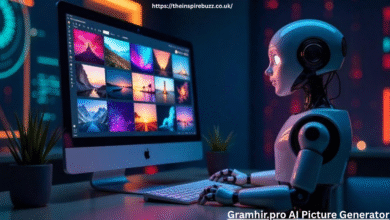Blog Gaming Dualmedia The Future of Interactive Entertainment and Digital Storytelling

The digital entertainment landscape has evolved dramatically over the past decade, giving rise to new forms of storytelling that blend different mediums for a more immersive experience. One such innovation is Blog Gaming Dualmedia — a hybrid approach that merges narrative-driven blog content with interactive gaming elements. This format allows players to enjoy both the depth of written storytelling and the excitement of gameplay, creating a unique and engaging entertainment experience.
Blog gaming refers to the integration of blog-style updates, journal entries, or story logs within a game’s universe. This method of delivering content is not just a marketing tool but a narrative extension that keeps players engaged even outside the actual gameplay. Dualmedia, on the other hand, takes it further by combining two distinct media formats — often written text and visual/interactive experiences — into one cohesive story.
The appeal of this approach lies in its ability to engage players on multiple levels. Readers who enjoy rich narratives can dive into detailed blog posts, lore updates, or character diaries, while gamers who crave action can actively participate in the unfolding events. This dual engagement bridges the gap between passive reading and active playing, offering a more dynamic experience than traditional games or blogs alone. As more creators experiment with this format, Blog Gaming Dualmedia is quickly gaining traction as a forward-thinking storytelling model in both indie and mainstream game development.
Understanding Dualmedia in the Gaming Industry
In the context of gaming, Dualmedia is all about synergy — the seamless fusion of two different media types to tell a unified story. While many games use cutscenes, audio logs, or comics to expand their lore, Dualmedia approaches take it a step further by weaving blog-style narratives directly into the gaming experience. Players are encouraged not only to play but also to read, interpret, and follow story threads that extend beyond the core gameplay.
One example could be an RPG where the in-game events are complemented by a fictional character’s blog, updated weekly with entries that reflect on recent missions, political developments in the game world, or behind-the-scenes character thoughts. These blog posts might contain hidden clues, codes, or strategies that can affect the gameplay itself, encouraging players to engage with both mediums to unlock the full experience.
Multimedia elements such as images, embedded videos, and music tracks further enhance this storytelling method. For instance, a horror game might post eerie “journal updates” with distorted audio recordings, which tie into puzzles players must solve in the game. By integrating such elements, creators can make their game worlds feel alive and evolving in real time.
This immersive approach helps maintain player interest long after they’ve logged out. Instead of waiting passively for the next patch or expansion, fans can actively follow and interact with the ongoing narrative through blog entries and media posts — keeping engagement high and the community thriving.
The Creative Process Behind Blog Gaming Dualmedia
Crafting a Blog Gaming Dualmedia experience requires a collaborative effort between storytellers, game designers, and multimedia specialists. The process often begins with defining the core narrative and deciding how much of it will be told through gameplay versus blog content. The blog side typically serves as a narrative bridge, offering insights, backstory, and parallel storylines that enrich the main game.
Writers must carefully match the tone, pacing, and style of the blog entries to the game’s atmosphere. For example, a cyberpunk-themed game might feature blogs written in a gritty, slang-filled style, while a fantasy game could use poetic language and in-universe terminology. Maintaining consistency between written content and in-game events is crucial to preserve immersion.
Game developers then integrate this content into the gameplay loop, ensuring that the blog is not just supplemental but also impactful. For instance, an entry might hint at an upcoming quest, reveal a hidden location, or provide backstory that changes the player’s understanding of the main plot. Multimedia artists enhance this with visuals, audio logs, or even short animations that bring the blog posts to life.
The main challenge lies in balancing the two mediums so that neither overshadows the other. A well-executed Blog Gaming Dualmedia project should feel like a single, unified experience where reading the blog and playing the game are equally rewarding — not optional side activities, but integral parts of the storytelling journey.
Benefits and Challenges of Blog Gaming Dualmedia
One of the most significant benefits of Blog Gaming Dualmedia is deep player immersion. By offering a story through multiple mediums, creators can build richer, more believable worlds. Players form stronger emotional connections to characters and events when they can follow them both inside and outside the game environment. This approach also helps with player retention, as audiences return not only for gameplay updates but also for fresh blog content.
Another advantage is community building. Blog updates often spark discussions, theories, and fan content, turning a game into a shared cultural experience. Developers can use these interactions to gauge player interest, adjust storylines, and foster loyalty among fans. From a marketing perspective, regularly published blog content keeps a game in the public eye, helping sustain long-term engagement.
However, this model also presents challenges. Balancing narrative complexity with gameplay flow is a delicate task — too much focus on the blog may alienate players who prefer action, while too little may render the blog irrelevant. There are also technical considerations, such as ensuring blog content is easily accessible across platforms and devices.
Maintaining consistency is another hurdle. Since blog posts often release on a fixed schedule, they must align perfectly with in-game events, requiring tight coordination between the writing and development teams. Despite these challenges, many creators find the benefits of Blog Gaming Dualmedia worth the effort, as it creates a distinctive and memorable player experience.
How to Start Your Own Blog Gaming Dualmedia Project
Launching a Blog Gaming Dualmedia project starts with choosing the right platforms and tools. Content management systems like WordPress or Ghost can host the blog portion, while game engines such as Unity or Unreal Engine handle the gameplay side. The two should be linked in a way that allows players to seamlessly transition between reading and playing.
Creators should begin with a strong narrative concept and determine how it will unfold across both mediums. For example, will the blog serve as a real-time “news outlet” within the game world, or will it be a character’s personal diary? The tone, format, and release schedule should be consistent to maintain immersion.
Multimedia integration is key to elevating the experience. Embedding concept art, short videos, or interactive polls within the blog can encourage player participation. Likewise, in-game prompts can direct players to blog entries, ensuring both mediums feed into each other.
Finally, building a community is essential for long-term success. Social media groups, Discord servers, and live Q&A sessions can give players a place to discuss blog entries and speculate about upcoming game content. By encouraging fan engagement, creators not only keep their audience invested but also gain valuable feedback that can shape future updates.
The Future of Blog Gaming Dualmedia
The future of Blog Gaming Dualmedia looks promising as technology continues to evolve. Virtual Reality (VR) and Augmented Reality (AR) could take immersion to the next level, allowing players to “step into” blog environments or view multimedia content as part of the game world. AI could also play a role, generating personalized blog updates based on a player’s choices and progress.
Mainstream adoption may be on the horizon, especially as streaming platforms begin experimenting with interactive storytelling formats. Live-blogging game events, developer diaries, and community polls could become integral parts of big-budget games. This would blur the lines between content creation, marketing, and gameplay even further.
For indie developers, Blog Gaming Dualmedia offers a cost-effective way to deliver rich narratives without the need for fully cinematic experiences. With clever writing and smart integration, even small teams can create compelling worlds that feel expansive and alive.
As the industry pushes toward more connected and participatory experiences, Blog Gaming Dualmedia stands out as a flexible and innovative approach. It’s not just a trend but a potential pillar of future game design — one where players don’t just play a game, they live in its story.
Conclusion
Blog Gaming Dualmedia represents an exciting frontier in interactive storytelling, merging the best elements of traditional blogging with the immersive nature of gaming. By engaging players through both written and interactive mediums, creators can build deeper narratives, sustain community interest, and foster long-term engagement. While it comes with challenges, the payoff in terms of immersion, loyalty, and creative freedom makes it a format worth exploring.
FAQs
1. What is Blog Gaming Dualmedia?
A hybrid storytelling format that combines blog-style narrative content with interactive gaming experiences.
2. How does Dualmedia differ from traditional gaming?
It uses two mediums — often written blogs and gameplay — to deliver a unified, immersive story.
3. What are the best tools for creating a blog gaming experience?
Popular choices include WordPress or Ghost for blogs and Unity or Unreal Engine for games.
4. Are there any famous games that use blog-style storytelling?
Yes, several indie and experimental games use developer blogs or fictional journals as part of the experience.
5. How can writers collaborate with game developers on Dualmedia projects?
Through shared narrative planning, consistent tone matching, and integrating story cues into gameplay.



